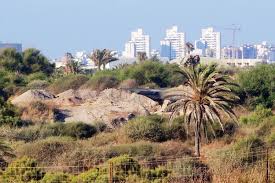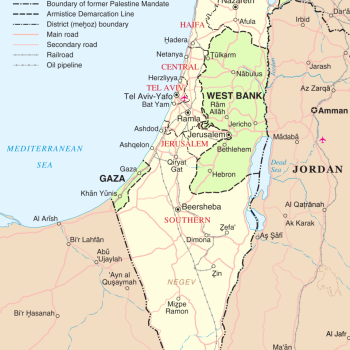Sometimes, myths are propagated as true history, and they need to be deconstructed. Such is the case with ancient Philistines. They were a migrant people who settled in southwestern Palestine to become the arch rival of the ancient Israelites. The historical books of the Jewish Bible are full of narratives about conflicts and battles between the Israelites and the Philistines. Both peoples were migrants to this portion of The Levant. The Bible is quite clear about how the Israelites came into this land; they came from Egypt where they had been slaves for 400 years. (They merely returned to some of the land where their forebears had lived.) How the Philistines migrated to this region has been a prime question in archaeology since the late nineteenth century.
 In my book, Palestine Is Coming: The Revival of Ancient Philistia (1990), I state (pp. 29-30), “The word Philistine means ‘migrant,’ signifying that the Philistines migrated to the southwestern coast of Palestine. There is uncertainty regarding both the place of their origin and the time of their migration. Most historians and archaeologists now maintain that the Philistines originated in the region of the Aegean Sea where Greece and Turkey are located. The predominant theory is that the Philistines, called ‘Sea Peoples,’ migrated from the mainland to the Mediterranean island of Crete. From there it is believed that they attacked Egypt by sea, were repulsed and settled for the first time in southwestern Palestine.”
In my book, Palestine Is Coming: The Revival of Ancient Philistia (1990), I state (pp. 29-30), “The word Philistine means ‘migrant,’ signifying that the Philistines migrated to the southwestern coast of Palestine. There is uncertainty regarding both the place of their origin and the time of their migration. Most historians and archaeologists now maintain that the Philistines originated in the region of the Aegean Sea where Greece and Turkey are located. The predominant theory is that the Philistines, called ‘Sea Peoples,’ migrated from the mainland to the Mediterranean island of Crete. From there it is believed that they attacked Egypt by sea, were repulsed and settled for the first time in southwestern Palestine.”
I later explain how this viewpoint became popular (p. 227-28), “In the eighth year of Pharaoh Ramses III (reign: c. 1197-1158 B.C.), there was a notable hostile invasion of foreigners into the northern frontier of Egypt. To repel the assault, ‘the Egyptians exhausted their strength completely.’
“According to numerous inscriptions on the fame Mortuary Temple walls in Medina Habu, Upper (southern) Egypt, the invasion ‘consisted of five groups: p-r-s-t (Philistines), t-k-r (Sikel?), s-k-r-s, d-n-n and w-s-s…. It is believed that because the Philistines were the larger of the five groups, the others became identified by that name after settling with them in the southwestern coastal plain of Palestine.
“The Medina Habu inscriptions were first deciphered and published in 1881. The confederated attackers were called ‘Sea Peoples’ because it was supposed that they crossed the Mediterranean Sea by boats and first invaded Egypt’s Mediterranean shoreline.
“Archaeologist Alassandra Nibbi claims that the designation Sea Peoples was premature. She maintains that close scrutiny of these inscriptions reveals that ym and ‘the Great Green’ were mistaken for the ‘The Great Sea.’ The Great Sea was the common name for the Mediterranean Sea in antiquity.”
I then subscribe in my book to Nibbi’s hypothesis by saying (p. 30), “some experts maintain that some, if not all of the Philistines travelled by land from Turkey down the Mediterranean coast to settle in Palestine and later attack Egypt.”
The Wikipedia article on “Sea Peoples” explains, “French Egyptologist Emmanuel de Rouge first used the term peuples de la mer (literally “peoples of the sea”) in 1855 in a description of reliefs on the Second Pylon at Medinet Habu documenting Year 8 of Ramesses III. Gaston Maspero, de Rouge’s successor at the College de France, subsequently popularized the term ‘Sea Peoples’—and an associated migration-theory—in the late 19th century. Since the early 1990s, the theory has been brought into question by a number of scholars.”
However, the Bible’s first book, Genesis, places the Philistines in The Levant during the time of Israel’s patriarchs–Abraham, Isaac, and Jacob (Gen 10.14; 21.32, 43; 5x in Gen 26). Historians and most Bible scholars regard these as anachronisms. I differ by taking the view, somewhat tentatively, that Philistines migrated, probably from the region of the Aegean Sea, several centuries before academics think they did, and the later and larger wave of Philistine migration to The Levant, apparently in the twelfth century B.C., joined that smaller community already living there.
 Regardless, I think the ascription “Sea Peoples” applied to Philistines needs to by regarded as a myth and retired to the dustbin of incorrect history. Perhaps there will be more clarity forthcoming on this when the Leon Levy Exhibition at Ashkelon divulges the true origin of the Philistines when they examine the uncorrupted DNA they obtained from the more than 200 skeletons they found three years ago in a Philistine cemetery at ancient Ashkelon. It is located in present Israel, but it was one of the five major cities of the ancient Philistines, called “the Philistine pentapolis.” See my posts on the newly-discovered Philistine skeletons by clicking here (7/11/16) and here (7/13/16). Also click here (8/3/16) for “Does the Bible Err by Saying Philistines Predate Israelites in the Levant.”
Regardless, I think the ascription “Sea Peoples” applied to Philistines needs to by regarded as a myth and retired to the dustbin of incorrect history. Perhaps there will be more clarity forthcoming on this when the Leon Levy Exhibition at Ashkelon divulges the true origin of the Philistines when they examine the uncorrupted DNA they obtained from the more than 200 skeletons they found three years ago in a Philistine cemetery at ancient Ashkelon. It is located in present Israel, but it was one of the five major cities of the ancient Philistines, called “the Philistine pentapolis.” See my posts on the newly-discovered Philistine skeletons by clicking here (7/11/16) and here (7/13/16). Also click here (8/3/16) for “Does the Bible Err by Saying Philistines Predate Israelites in the Levant.”













